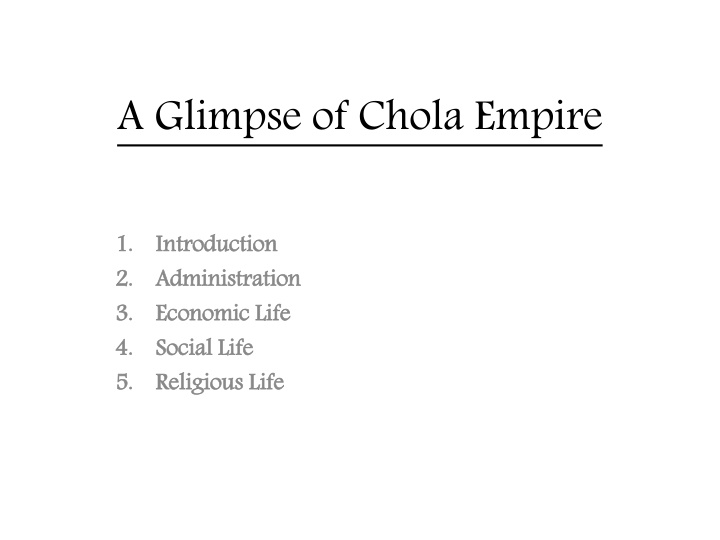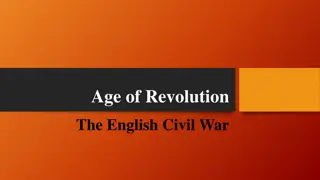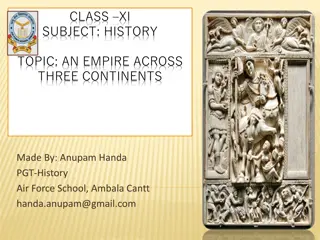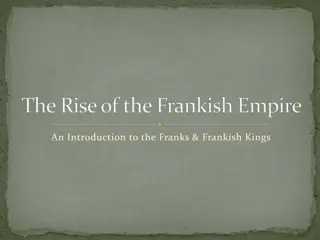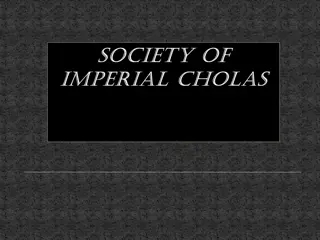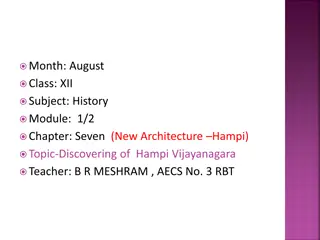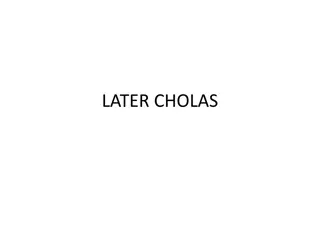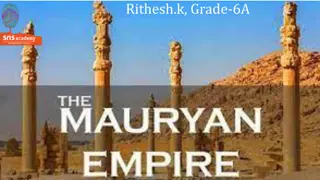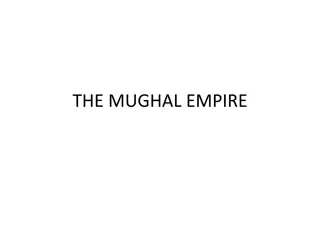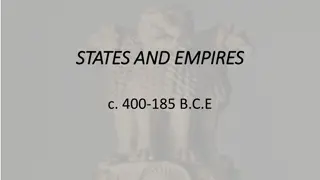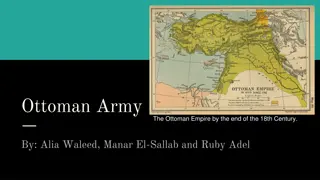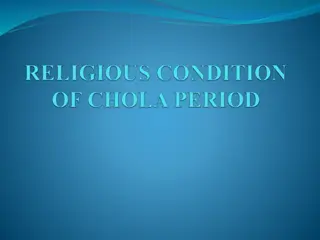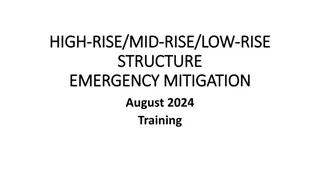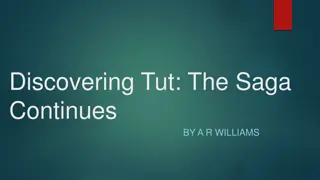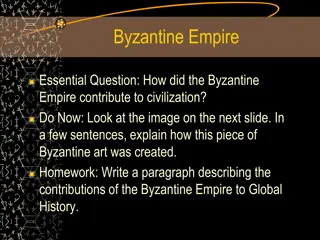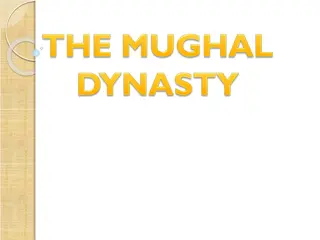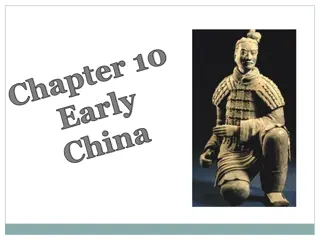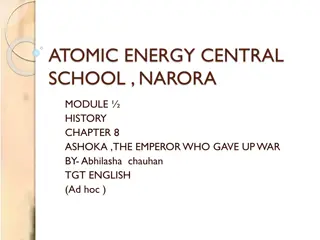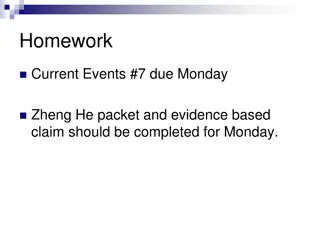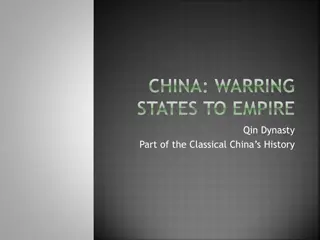A Glimpse of Chola Empire: Rise and Fall of an Ancient Dynasty
The Chola Empire, under rulers like Vijayalaya, Aditya I, and Rajaraja I, witnessed periods of expansion, conquests, and cultural advancements. Their efficient administration, economic prosperity, social structure, and religious practices are discussed, highlighting the empire's zenith under Arumolivarman. Despite flourishing for centuries, the Chola power eventually declined, succumbing to external pressures and internal challenges.
Download Presentation

Please find below an Image/Link to download the presentation.
The content on the website is provided AS IS for your information and personal use only. It may not be sold, licensed, or shared on other websites without obtaining consent from the author.If you encounter any issues during the download, it is possible that the publisher has removed the file from their server.
You are allowed to download the files provided on this website for personal or commercial use, subject to the condition that they are used lawfully. All files are the property of their respective owners.
The content on the website is provided AS IS for your information and personal use only. It may not be sold, licensed, or shared on other websites without obtaining consent from the author.
E N D
Presentation Transcript
A Glimpse of Chola Empire 1. 1. 2. 2. 3. 3. 4. 4. 5. 5. Introduction Administration Economic Life Social Life Religious Life Introduction Administration Economic Life Social Life Religious Life
Introduction The founder of the Chola Empire was Vijayalaya, who was first feudatory of the Pallavas of Kanchi. He captured Tanjore in 850 A.D. He established a temple of goddess Nishumbhasudini (Durga) there. Aditya I succeeded Vijayalaya. Aditya helped his overlord the Pallava king Aparajita against the Pandyas but soon defeated him and annexed the whole of the Pallava kingdom. By the end of the ninth century, the Cholas had defeated the Pallavas completely and weakened the Pandyas capturing the Tamil country (Tondamandala) and including it under their domination He then became a sovereign ruler. The Rashtrakuta king, Krishna II gave his daughter in marriage to Aditya. He erected many Shiva temples. He was succeeded in 907 A.D. by Parantaka I, the first important ruler of the Cholas. Parantaka I was an ambitious ruler and engaged himself in wars of conquest from the beginning of his reign. He conquered Madurai from the Pandya ruler Rajasimha II. He assumed the title of Maduraikonda (captor of Madurai). He, however, lost to the Rashtrakuta ruler Krishna III at the battle of Tokkolam in 949 A. D. The Cholas had to cede Tondamandalam to the adversary. At that point of time the Chola kingdom almost ceased to exist. It was a serious setback to the rising Chola power. The revival of Chola power began from the accession of Parantaka II who recovered Tondamandalam to reestablish dominance of the dynasty. The climax in Chola power was achieved under the successor of Parantaka II, Arumolivarman, who crowned himself as Rajaraja I in 985 AD the next thirty years of his rule formed the formative period of Chola imperialism
Introduction continued The Chola kingdom grew under him into an extensive and well-knit empire, efficiently organized and administered and possessing a powerful standing army and navy. Rajaraja I also encouraged Sri Mara Vijayottungavarman, the Sailendra ruler of Sri Vijaya to build a Buddhist Vihara at Negapatam. This vihara was called Chudamani Vihara after the father of Sri Mara. Kulottunga I (1070-1122 A.D.) the great-grandson of Rajaraja I, was the son of Rajendra Narendra of Vengi and Chola princess Ammangadevi (daughter of Rajendra Chola I). Thus Kulottunga I united the two kingdoms of the Eastern Chalukyas of Vengi and the Cholas of Thanjavur. The most important reforms carried out by him in the internal administration was the re- surveyal of land for taxation and revenue purposes. He was also titled Sungam tavirtta (he who abolished tolls). The Chola authority in Ceylon was overthrown by Vijayababu, the monarch of Ceylon during Kulottunga s reign. He sent a large embassy of 72 merchants to China and also maintained cordial relations with Sri Vijaya. The Chola Empire continued in a flourishing condition during the twelfth century but declined by the end of the thirteenth century. The Pandyan king Sundara rendered the final blow by seizing Kanchi in 1297 A.D. The place of the Cholas was taken over by the Pandyas and the Hoysalas. This marked the end of the Chola power.
Administration The Chola kings followed a highly efficient system of administration. The entire Tanjore district, parts of Trichy, Pudukottai and South Arcot districts formed the part of the Chola Mandalam. The Cholas had three major administrative divisions called Central Government, Provincial Government and Local Government. Tanjore was the capital of the Cholas. The efficient Chola administrative system has been well appreciated by many historians and rulers. King ship The king was the head of the administration. The Chola kings and Queens were considered as representatives of God. Their idols were kept in temples. The Chola kingship was hereditary. The Chola royal family followed the principle that eldest son should succeed the king to the Chola throne. The heir apparent was called Yuvaraja, The Chola monarchs enjoyed enormous powers and privileges. The Chola kings took up titles which marked their achievements. They lived in very big royal palaces. Kings were assisted by ministers and officials in their administration. Chola kings had tiger as their royal emblem. The royal priest Rajguru became the close confidant of the royal family. The king had council of ministers to aid and assists him. The king gave verbal orders (tiruvakya-kelvi) which were drafted by the private secretary and confirmed by the Olainayamak (Chief Secretary) and a Perundaram before its despatch by the Vidaiyadhikari (despatch clerk). They often advised him on important matters. An elaborate and complicated bureaucracy ran the government.
Administration Continued Central Government : The Central Government was under the headship of the King. Council of ministers and officials took active part in running the administration of Central Government. The officials tended to form a separate class in society. Perundaram were higher officials while sirutaram were lower officials. Peruvalis (trunk roads) helped in royal tours. The general tendency was to make the officers hereditary. The officials were paid by assignments of land called jivitas according to their status. Provincial administration: The Chola Empire was divided into nine provinces. They were also called mandalams. The head of the province was called viceroy. Close relatives of kings were appointed as viceroys. The Viceroys were in constant touch with the Central Government. Viceroys received orders from the king. They sent regular reply to the king. The viceroys had a large number of officials to assist them in the work of administration. Administrative Divisions: The success of the Chola administration depended more on the proper functioning of the administrative division us. Generally mandalams were named after the original names or the titles of the Chola kings. Each mandalam was divided into number of Kottams or Valanadus. Each kottam was sub divided into nadu. Each nadu was further divided into (Urs) villages which form part of the last unit of the administration. Uttaramerur inscriptions speak about the administration of the Cholas.
Administration Continued Village Administration The villages were mainly of three types. The first type constituted of an intercaste population where the land was held by all classes of people and paid taxes to the king in the form of land revenue. It was the most frequent type. The second was the Brahmadeya or agrahara villages which was granted to the Brahmins and was entirely inhabited by them. They were exempted from tax and were prosperous. The third type of village was the Devadana, which were villages granted to god. The revenues from these villages were donated to a temple. During Cholas the Devadana type of villages gained more popularity as the temples became the centres of life. There was remarkable autonomy at the village level. Chola officials participated in village administration more as observers than as administrators. The Cholas are best known for their local self government at the village level. We hear of three assemblies called the ur, sabha or mahasabha and nagaram. The ur was a general assembly of the village. The ur consisted of all the tax-paying residents of an ordinary village. TheAlunganattar was the executive committee and the ruling group of the ur. The ur open to all male adults but was dominated by the older members. The sabha was apparently an exclusively Brahmin assembly of the brahmadeya villages. The sabha had more complex machinery, which functioned largely through its committees called the variyams.
Administration Continued Election to the executive body and other committees of the ur and sabha appears to have been conducted by draw of lots from among those who were eligible. The nagaram was an assembly of merchants and were found more commonly in the trading centers. The Uttaramerur inscriptions of the Chola monarch Parantaka I of 919 A.D. and 921 A.D may be said to constitute a great landmark in the history of the Chola village assemblies. It gives details about the functioning and constitution of the local sabha. The 919 A.D. inscriptions framed the rules for election and 921 A.D. incriptions amended them. There were 30 wards (kudumbus) each nominatin members for selections of people with the prescribed qualifications. Elections from each ward was by lot (kudavolai, literally means pot- ticket) for a period of one year. Of the thirty so selected, twelve members who had earlier served in the garden and tank committee and were advanced in age, were assigned to the samvatsarvariyam or annual committee, twelve to the Tottavariyam or the garden committee and 6 members to the Eri- variyam or tank committee Pancha-variyam (a standing committee) and Pon-variyam (gold committee) were the other two committees. Variyapparumakal were the members of the committee, Perunguri were the members of the Mahasabha; Nyayaffarwas the Judicial committee and Madhyasthas, a small staff of paid servants in the village assisted the committees and maintained village records. The Assembly generally met in the temple, or under a tree or near a tank The sabha possessed proprietary rights over communal lands. It also controlled private lands of the villages. It reclaimed forest and waste land. It aided in the assessment of the produce and land revenue. It collected land revenue and had the power to sell the land in question, in cases of default. It also had the powers of taxation for purposes connected with the village and of remission of taxation for specific reasons.
Economic Life Land tax constituted the single largest source of income of the Chola state. It was generally assessed at one-third of the produce. The village assembly took land tax and local levies. Cattle rearing were a subsidiary occupation. Trade with foreign countries was an important feature of the Cholas mercantile activities. The rulers built a network of royal roads that were useful for trade as well as for the movement of the army. There were gigantic trade guilds that traded with Java and Sumatra. South India exported textiles, spices, drugs, jewels, ivory, horn, ebony and camphor to China. Trade brought considerable prestige and affluence to the Cholas. Kalanju was the currency prevalent in the Chola kingdom. Thus the land revenue was the main source of income of the Chola Government. Proper land survey was made. Lands were classified as taxable land and non taxable land. There were many grades in the taxable lands. Land revenue differed according to these grades. Generally 1/6 of the land yield was collected as tax either in cash or in kind or both according to the convenience of the farmers. Besides land revenue, there were some other sources of income like customs and tolls. Taxes on mines, ports, forests and salt pans were collected. Professional tax and house tax were also collected. Many other taxes were levied. Tax burden was more on the society. Sometimes due to failure of rain and famine people could not pay tax.
Social Life The caste system was the basis of the social organization under the Cholas. Society was divided into a number of social groups or castes. Each caste was hereditary and constituted an occupational group. Bramhanas occupied a privilege position in the society. They combined both religious authority and economic power. They were exempted from taxes, owned and enjoyed land with full royal support. Their main duties included learning and teaching of the Vedas and performing rituals and ceremonies. Some of them served as chief priests of the temple. Some of them were more adventurous and engaged themselves in trade. They were given lighter punishments in case of offences committed. The almost total absence of Kshatriya institutions necessitated an alliance between sections of brahmanas and the dominant peasantry. The Nattar was the dominant peasant community, and the cultivators were the subordinate client group of the nattars. The newly assimilated castes from marginal tracts were often combined in mass groupings of Idangai (left handed castes) and Valangai (right handed castes. Rudimentary hierarchy of social groups from classical times according to the Silapadikaram were vellalar-cultivator, kovalar-cowherds and shepherds, vedar-hunters, Padaiyacciar- artisan groups and armed men and valaiyar-fishermen. Worship of deceased rulers and construction of temples as tributes to dead kings was a special feature of the Chola period. They were given lighter punishments in case of offences committed. The almost total absence of Kshatriya institutions necessitated an alliance between sections of brahmanas and the dominant peasantry. The Nattar was the dominant peasant community, and the cultivators were the subordinate client group of the nattars. The newly assimilated castes from marginal tracts were often combined in mass groupings of Idangai (left handed castes) and Valangai (right handed castes. Rudimentary hierarchy of social groups from classical times according to the Silapadikaram were vellalar-cultivator, kovalar-cowherds and shepherds, vedar-hunters, Padaiyacciar- artisan groups and armed men and valaiyar-fishermen. Worship of deceased rulers and construction of temples as tributes to dead kings was a special feature of the Chola period.
Religious Life Sailendra kings were Mahayan Buddhist and ruled over Sumatra, Bali, Cambodia and Malaya. Sailendra Kings had constructed a Buddhist Vihara at Nagapattinam, Tamilnadu. (area under Chola control) Name of this Vihara: Chula-mani-varma-vihara. Chola King Rajaraja Chola 1 had issued a Charter to provide money to this Vihara This charter was inscribed on a copper plate and preserved at Leiden University of Netherlands, and proves that Chola patronized Buddhism as well.
